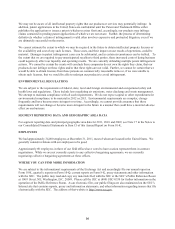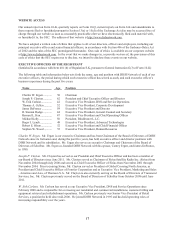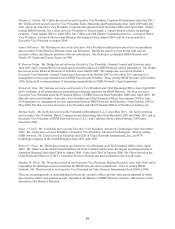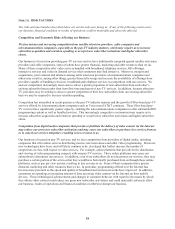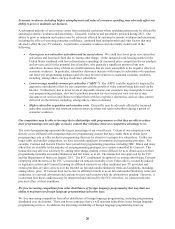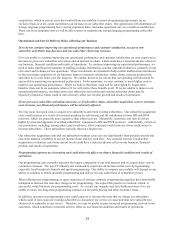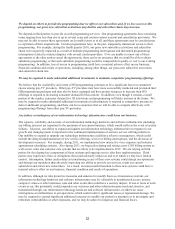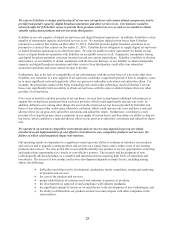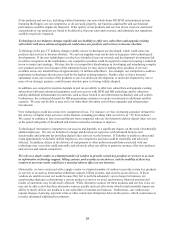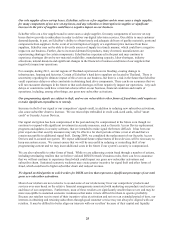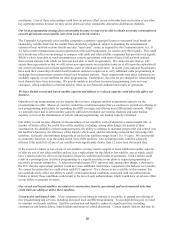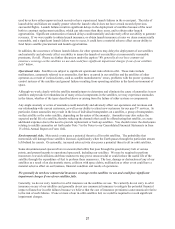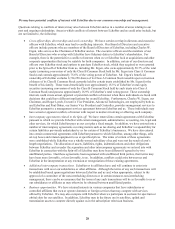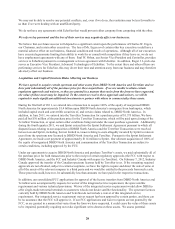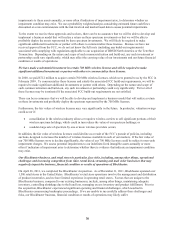Dish Network 2011 Annual Report Download - page 36
Download and view the complete annual report
Please find page 36 of the 2011 Dish Network annual report below. You can navigate through the pages in the report by either clicking on the pages listed below, or by using the keyword search tool below to find specific information within the annual report.
26
26
constraints. Loss of these relationships could have an adverse effect on our subscriber base and certain of our other
key operating metrics because we may not be able to develop comparable alternative distribution channels.
Our local programming strategy faces uncertainty because we may not be able to obtain necessary retransmission
consent agreements at acceptable rates from local network stations.
The Copyright Act generally gives satellite companies a statutory copyright license to retransmit local broadcast
channels by satellite back into the market from which they originated, subject to obtaining the retransmission
consent of local network stations that do not elect “must carry” status, as required by the Communications Act. If
we fail to reach retransmission consent agreements with such broadcasters, we cannot carry their signals. This could
have an adverse effect on our strategy to compete with cable and other satellite companies that provide local signals.
While we have been able to reach retransmission consent agreements with most of these local network stations,
there remain stations with which we have not been able to reach an agreement. We cannot be sure that we will
secure these agreements or that we will secure new agreements on acceptable terms (or at all) upon the expiration of
our current retransmission consent agreements, some of which are short-term. In recent years, national broadcasters
have used their ownership of certain local broadcast stations to require us to carry additional cable programming in
exchange for retransmission consent of their local broadcast stations. These requirements may place constraints on
available capacity on our satellites for other programming. Furthermore, the rates we are charged for retransmitting
local channels have been increasing. We may be unable to pass these increased programming costs on to our
customers, which could have a material adverse effect on our financial condition and results of operations.
We have limited owned and leased satellite capacity and failures or reduced capacity could adversely affect our
business.
Operation of our programming service requires that we have adequate satellite transmission capacity for the
programming we offer. Moreover, current competitive conditions require that we continue to expand our offering of
new programming, particularly by expanding local HD coverage and offering more HD national channels. While
we generally have had in-orbit satellite capacity sufficient to transmit our existing channels and some backup
capacity to recover the transmission of certain critical programming, our backup capacity is limited.
Our ability to earn revenue depends on the usefulness of our satellites, each of which has a limited useful life. A
number of factors affect the useful lives of the satellites, including, among other things, the quality of their
construction, the durability of their component parts, the ability to continue to maintain proper orbit and control over
the satellite’s functions, the efficiency of the launch vehicle used, and the remaining on-board fuel following orbit
insertion. Generally, the minimum design life of each of our satellites ranges from 12 to 15 years. We can provide
no assurance, however, as to the actual useful lives of the satellites. Our operating results could be adversely
affected if the useful life of any of our satellites were significantly shorter than 12 years from the launch date.
In the event of a failure or loss of any of our satellites, we may need to acquire or lease additional satellite capacity
or relocate one of our other satellites and use it as a replacement for the failed or lost satellite, any of which could
have a material adverse effect on our business, financial condition and results of operations. Such a failure could
result in a prolonged loss of critical programming or a significant delay in our plans to expand programming as
necessary to remain competitive. A relocation would require FCC approval and, among other things, a showing to
the FCC that the replacement satellite would not cause additional interference compared to the failed or lost satellite.
We cannot be certain that we could obtain such FCC approval. If we choose to use a satellite in this manner, this
use could adversely affect our ability to satisfy certain operational conditions associated with our authorizations.
Failure to satisfy those conditions could result in the loss of such authorizations, which would have an adverse effect
on our ability to generate revenues.
Our owned and leased satellites are subject to construction, launch, operational and environmental risks that
could limit our ability to utilize these satellites.
Construction and launch risks. A key component of our business strategy is our ability to expand our offering of
new programming and services, including increased local and HD programming. To accomplish this goal, we need
to construct and launch satellites. Satellite construction and launch is subject to significant risks, including
construction and launch delays, launch failure and incorrect orbital placement. Certain launch vehicles that may be


